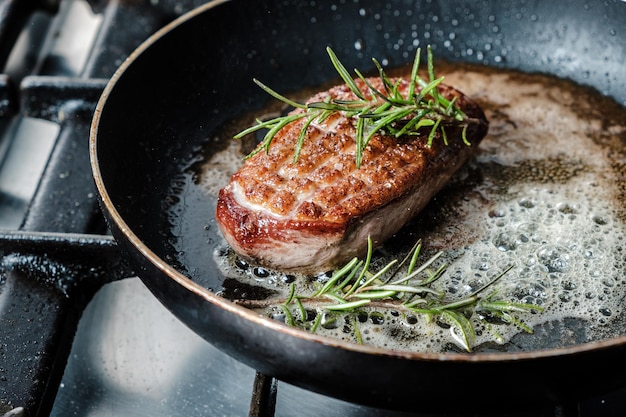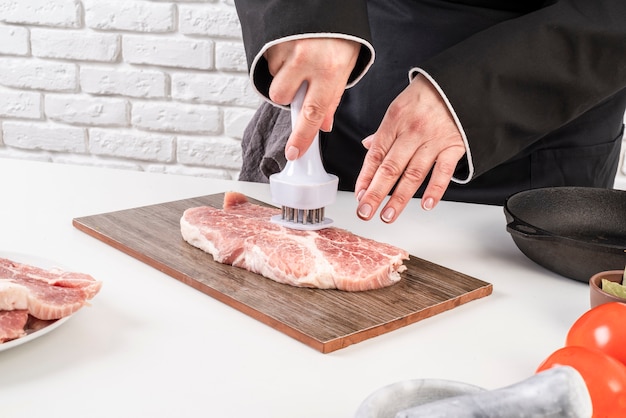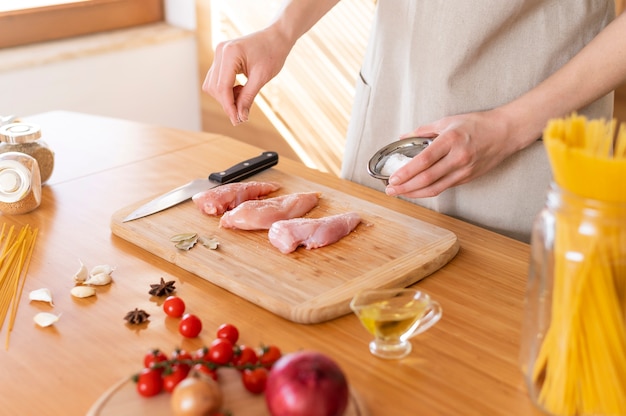I've always been a bit of a food enthusiast, the kind who gets ridiculously excited about a new recipe and spends hours poring over cookbooks and blogs, trying to master the art of cooking. And for me, there's something truly magical about cooking pork chops. The sizzle as they hit the pan, the beautiful golden-brown crust, and the succulent, juicy meat inside – it's a symphony of flavours and textures that I could never tire of. But let's be real, mastering the art of cooking perfect pork chops, especially thick cuts, isn't exactly a walk in the park. Those beauties can be tricky to get right, with the risk of ending up with dry, overcooked meat. That's why I've spent countless hours researching, experimenting, and refining my techniques to find the perfect cooking time for those thick cuts. And trust me, it's a journey worth taking.
(Part 1) The Basics of pork chop cooking: A Culinary Primer

Before we delve into the intricacies of cooking thick pork chops, let's establish a solid foundation. Cooking time is undoubtedly crucial, but so is understanding the type of cut, the chosen cooking method, and your desired level of doneness.
A Tale of Two Cuts: Bone-In vs. Boneless
The first decision you need to make is the type of pork chop you're working with. There are two main types: bone-in and boneless. bone-in pork chops are generally thicker and meatier than their boneless counterparts, meaning they'll require longer cooking times. This is because the bone helps retain heat and moisture, ensuring a juicier result. Boneless chops, on the other hand, are usually thinner and cook faster, making them perfect for a quicker weeknight meal.
Choosing the Right Cooking Method: A culinary adventure
Next, you need to choose your cooking method. Pork chops can be cooked in various ways, each with its own unique advantages and disadvantages.
- Pan-frying: This method is a classic for a reason. It produces a beautiful, crispy crust and juicy interior. However, it requires careful monitoring to avoid overcooking.
- Baking: This method is perfect for cooking multiple chops at once and ensures even cooking. It's a more hands-off approach, allowing you to focus on other tasks while the chops cook in the oven. However, it might not produce the same crispy crust as pan-frying.
- Grilling: This method gives pork chops a smoky flavour and beautiful grill marks. It's a fantastic option for those warm summer evenings. However, it's best suited for boneless chops, as thick bone-in chops can be difficult to cook evenly on the grill.
- Roasting: This method is ideal for cooking larger cuts of meat, like pork roasts. It's less common for individual pork chops.
Understanding Doneness Levels: Finding Your Perfect Bite
Finally, you need to determine your desired level of doneness. The USDA recommends cooking pork chops to an internal temperature of 145°F (63°C) for safe consumption. However, personal preferences vary widely.
- Medium-rare: 135-140°F (57-60°C) – This results in a slightly pink centre and a juicy texture, perfect for those who prefer a more tender bite.
- Medium: 145-150°F (63-66°C) – This is the USDA recommended level, with a slightly pink centre and a tender texture, a classic choice for many.
- Medium-well: 155-160°F (68-71°C) – This results in a very slightly pink centre and a firm texture, a good choice for those who prefer a less pink centre.
- Well-done: 165°F (74°C) – This results in a completely cooked-through centre and a firm texture, ideal for those who prefer their meat cooked through.
(Part 2) The Impact of Thickness: A Key Factor in Cooking Time

Now that we've laid the groundwork, let's talk about the real star of the show: the thickness of your pork chops. It plays a crucial role in determining the optimal cooking time. Just like a thick steak, thick pork chops require more time to cook through evenly, ensuring a juicy and flavorful result. Here's a general rule of thumb to help you estimate cooking time based on thickness:
Estimating Cooking Time Based on Thickness: A Handy Guide
| Thickness (in inches) | Cooking Time (in minutes per side) |
|---|---|
| 1/2 inch | 3-4 minutes |
| 3/4 inch | 4-5 minutes |
| 1 inch | 5-6 minutes |
| 1 1/2 inches | 6-7 minutes |
Keep in mind that these are just general guidelines. The actual cooking time may vary depending on the cooking method, the temperature of your pan or oven, and the specific cut's thickness. It's always best to err on the side of caution and slightly undercook, as you can always cook it a bit longer if needed.
(Part 3) The Secret Weapon: Using a meat thermometer for Perfect Doneness

If you want to ensure perfectly cooked pork chops every time, a meat thermometer is your absolute best friend. It takes the guesswork out of cooking, allowing you to check the internal temperature of the meat and provide a precise reading of its doneness, ensuring that your chops are cooked to your exact preference.
- Accuracy is Key: A meat thermometer eliminates the uncertainty of guessing, ensuring that your chops are cooked to your desired level of doneness, whether it's a juicy medium-rare or a well-done centre.
- Avoid Overcooking: Overcooking can lead to dry, tough meat, and no one wants that! A meat thermometer helps you prevent this by ensuring that you don't cook the chops for too long, especially important for thick cuts.
- Safe and Delicious: A meat thermometer ensures that your pork chops are cooked to a safe internal temperature, protecting you from any potential foodborne illnesses and allowing you to enjoy your meal without worry.
How to Use a Meat Thermometer: A Step-by-Step Guide
1. Insert the thermometer into the thickest part of the chop, making sure it doesn't touch the bone. 2. Wait for a few seconds until the thermometer registers the internal temperature. 3. Remove the chop from the heat once the desired temperature is reached.
(Part 4) Mastering the Art of Pan-Frying: The Crispy Crust Masterclass
Pan-frying is my go-to method for cooking pork chops. It's quick, easy, and produces a beautifully crispy crust and a juicy interior. But getting it right requires a few key tricks that I've learned over the years.
1. Start with a Hot Pan: The Foundation of a perfect sear
A hot pan is essential for achieving a good sear, creating that beautiful golden-brown crust. Heat your pan over medium-high heat for a few minutes before adding the chops. You'll know your pan is ready when a drop of water sizzles and evaporates quickly when added to the pan.
2. Dry the Chops Thoroughly: Preventing a Soggy Crust
Pat the chops dry with paper towels before adding them to the pan. This helps prevent steaming, which can lead to a soggy crust. It's essential for a crisp, flavorful exterior.
3. Season Generously: Adding Depth and Flavor
Salt and pepper are the basics, but don't be afraid to get creative with your seasonings. Herbs, spices, and even a touch of paprika can add flavour and depth to your chops. Try a sprinkle of rosemary, thyme, or a pinch of garlic powder. Experiment and find your favorite combinations!
4. Don't Overcrowd the Pan: Ensuring Even Cooking
Give the chops enough space to cook evenly. If the pan is overcrowded, the temperature will drop, and the chops will steam instead of sear, resulting in a less-than-ideal outcome.
5. Flip Only Once: Maintaining the Perfect Crust
Resist the urge to flip the chops multiple times. Flipping them too often can disrupt the sear and lead to a less crispy crust. Let the first side develop a nice golden brown crust before flipping and repeating on the other side.
6. Use a Meat Thermometer to Check for Doneness: Ensuring a Perfect Bite
Once the chops have a nice golden brown crust on one side, flip them over and continue cooking until they reach your desired level of doneness. Don't forget to use your trusty meat thermometer to ensure that the chops are cooked to your liking.
(Part 5) Baking for Even Cooking: A Hands-Off Approach
While pan-frying is fantastic for achieving a crispy crust, baking is a great option for cooking multiple chops evenly. It's a more hands-off approach, allowing you to focus on other tasks while the chops cook in the oven.
1. Preheat the Oven: Setting the Stage for Even Cooking
Preheat your oven to 375°F (190°C). This ensures that the chops cook evenly and quickly.
2. Season the Chops: Adding Flavor and Depth
Season the chops with salt, pepper, and any other herbs or spices you like.
3. Place the Chops on a Baking Sheet: Preparing for the Oven
Place the seasoned chops on a baking sheet lined with parchment paper or foil. This will prevent sticking and ensure easy cleanup.
4. Bake until Cooked Through: Achieving Perfect Doneness
Bake the chops for 20-25 minutes, or until they reach an internal temperature of 145°F (63°C).
5. Let the Chops Rest: Enhancing Tenderness and Flavor
Once the chops are cooked, remove them from the oven and let them rest for a few minutes before serving. This allows the juices to redistribute throughout the meat, resulting in a more tender and flavorful chop.
(Part 6) The Grill Master's Guide: Smoky Flavor and Beautiful Grill Marks
Grilling is a popular method for cooking pork chops, adding a smoky flavour and beautiful grill marks. However, it's best suited for boneless chops, as thick bone-in chops can be difficult to cook evenly on the grill.
1. Prepare the Grill: Setting the Stage for Grilling Success
Preheat your grill to medium-high heat. If you're using a gas grill, make sure the burners are evenly distributed. If you're using a charcoal grill, make sure the coals are evenly spread and glowing red.
2. Season the Chops: Adding Flavor to Your Grilled Delights
Season the chops with salt, pepper, and any other herbs or spices you like.
3. Grill until Cooked Through: Achieving Perfectly Grilled Chops
Grill the chops for 4-6 minutes per side, or until they reach an internal temperature of 145°F (63°C).
4. Let the Chops Rest: Ensuring Tenderness and Juiciness
Once the chops are cooked, remove them from the grill and let them rest for a few minutes before serving. This allows the juices to redistribute throughout the meat, resulting in a more tender and flavorful chop.
(Part 7) Tips for Achieving Tender and juicy pork chops: Masterful Techniques
Here are a few additional tips to help you achieve perfectly tender and juicy pork chops, regardless of the cooking method you choose:
- Don't Overcook: Pork chops can quickly become dry and tough if overcooked. Use a meat thermometer to ensure that they are cooked to your desired level of doneness.
- Let the Chops Rest: After cooking, let the chops rest for a few minutes before slicing and serving. This allows the juices to redistribute throughout the meat, resulting in a more tender and flavorful chop.
- Use a Marinade: Marinating pork chops before cooking can help tenderize the meat and add flavour. Use a marinade made with acidic ingredients, such as lemon juice or vinegar, to break down the tough proteins in the meat.
- Basting: Basting pork chops while cooking can help keep them moist and flavorful. Use a basting brush to apply a mixture of butter, herbs, and spices to the chops during cooking.
- Consider a Brine: Brining pork chops before cooking can help them retain moisture and improve their tenderness. Brining involves soaking the chops in a salt water solution for a few hours or overnight, adding a delicious flavor profile and juiciness.
(Part 8) pork chop recipes: Beyond the Basics – A Culinary Adventure
Once you've mastered the art of cooking perfect pork chops, it's time to get creative with your recipes. There are endless possibilities when it comes to flavour combinations and cooking techniques.
1. pan-seared pork chops with Apple and Sage Sauce: A Classic with a Twist
This recipe combines the classic flavours of apple and sage, creating a delightful and comforting meal. The pan-searing technique creates a beautiful crust, while the apple and sage sauce adds a touch of sweetness and savory depth.
2. Honey Garlic Glazed Pork Chops: Sweet and Savory Perfection
Sweet and savory, this recipe is sure to please even the pickiest eaters. The honey garlic glaze adds a beautiful sheen and a delicious flavour combination that will have you coming back for more.
3. grilled pork chops with Mango Salsa: A Tropical Delight
This recipe brings a touch of tropical flavour to your grilled pork chops. The mango salsa adds a vibrant burst of freshness and sweetness, complementing the smoky flavor of the grilled pork perfectly.
4. Baked Pork Chops with Rosemary and Garlic: Simple Elegance
This recipe is a simple and elegant way to prepare pork chops. The rosemary and garlic add a fragrant and flavorful touch, while the baking method ensures even cooking and a tender, juicy result.
5. Pork Chops with Dijon Mustard Cream Sauce: Rich and Creamy Goodness
This recipe is rich and creamy, with a hint of mustard flavour. The Dijon mustard cream sauce adds a sophisticated touch, making this dish perfect for a special occasion.
FAQs: Answering Your Pork Chop Questions
- Q: Can I cook frozen pork chops?
- A: While you technically can, it's not recommended. Frozen pork chops will take longer to cook and may not cook evenly. It's best to thaw them in the refrigerator overnight before cooking, ensuring a more consistent and delicious result.
- Q: What happens if I overcook pork chops?
- A: overcooked pork chops will be dry and tough. They may also have a greyish colour, indicating that they've lost their moisture. It's important to use a meat thermometer to prevent overcooking, ensuring a tender and juicy result.
- Q: How do I know if my pork chops are done?
- A: The best way to tell if pork chops are done is to use a meat thermometer. The USDA recommends cooking pork chops to an internal temperature of 145°F (63°C). However, personal preferences vary, so you can adjust the temperature accordingly. If you don't have a meat thermometer, you can check for doneness by pressing on the centre of the chop. If it springs back, it's done.
- Q: What are some side dishes that go well with pork chops?
- A: Pork chops pair well with a variety of side dishes, including mashed potatoes, roasted vegetables, salads, and rice. Consider a creamy coleslaw, a vibrant green salad, or a comforting side of mashed potatoes for a complete meal.
- Q: Can I reheat pork chops?
- A: Yes, you can reheat pork chops. The best way to reheat them is in the oven or microwave. However, it's important to make sure they are heated to an internal temperature of 165°F (74°C) to ensure safety.
I hope this article has shed some light on the secrets of cooking perfect pork chops, especially those thick cuts. Remember, practice makes perfect. Don't be afraid to experiment with different techniques and flavours. And most importantly, enjoy the delicious results of your culinary efforts!
Everyone is watching

Corn on the Cob: The Ultimate Guide to Perfectly Cooked Ears
Healthy MealsAh, corn on the cob. Just the name evokes images of sunny days, barbecues, and that sweet, juicy flavour that ...

Perfect Pork Roast Oven Cooking Time: A Guide to Delicious Results
Healthy MealsThere's something truly satisfying about a perfectly roasted pork. The aroma alone is enough to make your mout...

Scallops: The Ultimate Guide to Perfect Cooking
Healthy MealsAh, scallops. Those delicate, sweet, and utterly delicious morsels of the sea. They hold a special place in my...

Spaghetti Squash: The Ultimate Guide to Cooking and Serving
Healthy MealsRemember that time you saw spaghetti squash at the supermarket, looking all bumpy and strange, and thought, "W...

Salmon Cooking Times: Perfect Guide for Every Recipe
Healthy MealsLet me tell you, cooking salmon is an art form. It's all about getting that perfect balance: juicy and tender,...
